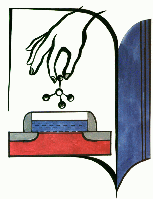 |
|||||
|
Home Nano & Giga 2002 |
|||||
|
Nano & Giga 2004 Web Site |
|||||
|
SWN2003 Workshop Phoenix, AZ |
|||||
| Moscow Visitor Tips | |||||
| FAQ | |||||
| Laptop Setup Tips | |||||
| Speakers | |||||
| Sponsors | |||||
|
Purchase Book of Abstracts |
|||||
| Abstract Submission | |||||
Proceedings
|
|||||
| Instructions for Authors | |||||
| Meeting Profile | |||||
| Conference Program | |||||
|
Nano & Giga Challenges
Summer School September 10-11, 2002
|
|||||
|
Satellite Symposium
Software Development September 15-16, 2002
|
|||||
| Exposition | |||||
| Accommodations | |||||
| Food and More | |||||
| City Transportation | |||||
| Social Program | |||||
| Visa and Travel Info | |||||
| Contact Information | |||||
| Financial Aid | |||||
| Awards | |||||
| Useful Links | |||||
| For Organizers Use |
Palace of ScienceThe land presently occupied by the Palace of Science was inhabited long ago. There are a number of architectural monuments here that are the contemporaries and witnesses of remote past. Different centuries live here together. Like sun is reflected in a drop of water, the important events of Russia's history are mirrored in this piece of Moscow: change of economic models, change of people's way of life. In XVI century and later the today's territory of the Palace of Science was situated in Bolshaya Konyushennaya Sloboda At the edge of XVII and XIX centuries Prechistenka Street with its alleys was an embodiment of feudal Moscow where the nobility ruled resting on its economical power and political authority. In late XVIII early XIX the estate that was on the site of the present Palace of Science belonged to Moscow's Military Governor Ivan Petrovitch Arkharov. In 1818 the house was bought by a senator Ivan Alexandrovitch Naryshkin. Later the house was owned by duke Gagarina, and then by dukes the Trubetskoy. The history of the Palace of Science is also connected with Decembrists. Here in the house of Musin-Pushkin Mikhail Mikhailovich Naryshkin was visited by Nikolay Vasilyevitch Gogol who worked at that time on the second volume of Dead Souls and was interested in the activity of Decembrists wishing to describe the exile of Tentetnikov to Siberia and removal of Ulenka to him. In 1865 the estate passed from @prince Trubetskoy to the Konshins. The Konshins bought the estate of Trubetskoy in 1865 and reconstructed it. The manufactory and usurious transactions made Ivan Nikolayevitch a very rich man. He had no children and before his death in 1898 he left all his fortune of more than 10 million rubles to his 65-year-old wife. A logical question arises why Alexandra Ivanovna Konshina being in declining years (she was 77) decided to reconstruct this luxurious building. The house reconstructed with great luxury. Especially remarkable was the winter garden -- the today's dining-hall. The interior the marble was brought from Italy, and the bronze decoration and marble sculpturesfrom Paris. A huge piece of glass was ordered in Italy. It was transported to Russia in a specially equipped carriage. The Palace of Science was opened in Prechistenka Street in 1922, Prechistenka and the neighboring streets (Pirogovskaya Street, Volkhonka Street) accommodated a lot of the scientific institutes,high schools, Academy of Arts, Moscow University's departments of the humanities, the Russian State Library, and numerous museums. The Palace of Science has been active 75 years already. It was started by the leading Moscow scientists S.A. Chaplygin, E.A. Chudakov, M.V. Kirpichev, I.I. Badin, V.N. Obraztsov, N.D. Zelinsky, B.D. Grekov, I.I. Mints, V.A. Engelgardt, B.A. Rybakov, and others. The first Chairman of the Palace of Science was the RSFSR People's Commissar of Public Health Nikolay Alexandrovitch Semashko, a public figure and scientist. Also he was a leader of a medical society of the Palace. The industrial and technical society was organized in 1933 on the initiative of the Academician S.A. Chaplygin, Professor N.S. Dyurbaum, and other scientists. It took the key position in the scientific activity of the Palace of Science. Later these groups became independent societies within the Palace of Science. The agricultural society was established soon after the Palaces of Sciences was opened. A.N. Lebedyantsev, the honored scientist, was its first leader. The Society comprised the following groups: economy and organization of agriculture, mechanization of agriculture, animal breeding, crop production, agricultural chemistry, and soil science. After the October Revolution the territory of the Palace remained the same but the luxury of interior decoration and furniture gradually deteriorated. The building fell into decay, and in 1990 it was decided to close the Palace of Science for major repair. Under social and economic conditions of that time it meant that the Palace would be closed forever. But in 1991, due to some staff transfer, and performance of a huge amount of renovation and restoration work, the Palace got a new life and today it appears to look just like it looked in the past century. |